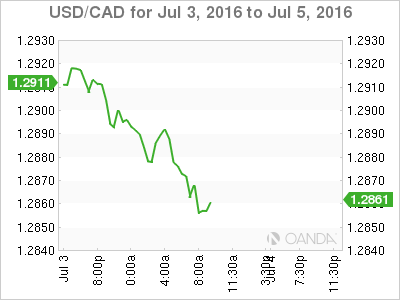The Canadian dollar has posted gains on Monday's session, continuing the upward trend which marked Friday. USD/CAD is trading at 1.2860. The Canadian dollar posted strong gains on Friday, which was somewhat surprising as Canadian markets were closed for Canada Day.
US markets are closed on Monday for Independence Day, so there are no scheduled US events. Canada will publish Manufacturing PMI and the BoC Business Outlook Survey.
With the financial markets understandably focused on the stunning Brexit vote, the Federal Reserve and future monetary moves have shifted to the back-burner. That could change next week, as Fed Chair Janet Yellen will deliver a speech in Philadelphia.
Will she provide any clues about a rate move? Yellen and her colleagues have sounded cautious about the US economy, and unless we see stronger employment and inflation numbers in the second half of 2016, the Fed may remain on the sidelines until 2017.
Gone are the heady days of last December, when the Fed hiked rates and hinted that there was more to come in 2016, perhaps as many as four hikes. Bottom line? Traders shouldn’t count on an imminent rate hike to boost the US dollar; rather, the direction of the currency will largely be data-dependent – the Fed is unlikely to budge unless we see significantly improved employment and inflation numbers.
The Brexit vote to leave the European Union continues to cause deep instability in Europe and the UK, and wiped out a staggering $3 trillion from global stock markets. Although the financial markets have stabilized, the British pound has shed about 11 percent since the vote, and continued to drop last week.
British politicians have sought to calm the public and the markets, but the pound’s sharp drop on Thursday underscores that the situation is anything but normal. The country’s political picture is fluid, as the Conservatives are choosing a new leader, the Labor Party is in turmoil and elections may not be far away.
On the financial front, the pound and the markets have taken a beating and London’s position as a world financial center has been shaken. The UK may have voted “Out”, but there is no timetable as to when the exit will take place or what type of trade agreement will define the new economic relationship between the EU and Britain.
British leaders are in no rush to leave, but European leaders have called on Britain to exit as soon as possible in order to minimize the uncertainty and instability caused by the Brexit vote. When it comes to the EU, Britain finds itself in limbo (“not in nor out”), and such uncertainty could weigh on risk currencies like the Canadian dollar until some decisions are reached regarding Britain’s exit from the EU.
USD/CAD Fundamentals
Monday (July 4)
- 9:30 Canadian RBC Manufacturing PMI
- 10:30 BOC Business Outlook Survey
* Key releases are in bold
*All release times are GMT
USD/CAD for Monday, July 4, 2016

USD/CAD July 4 at 8:30 GMT
Open: 1.2910 Low: 1.2849 High: 1.2915 Close: 1.2855
USD/CAD Technical
| S1 | S2 | S1 | R1 | R2 | R3 |
| 1.2562 | 1.2711 | 1.2830 | 1.2952 | 1.3048 | 1.3182 |
- USD/CAD was flat in the Asian session and has posted gains in the European session
- 1.2830 is a weak support line
- 1.2952 ha strengthened in resistance following losses by USD/CAD in the Monday session
Further levels in both directions:
- Below: 1.2830, 1.2711 and 1.2562
- Above: 1.2952, 1.3048 and 1.3182
- Current range: 1.2952 to 1.3048
OANDA’s Open Positions Ratio
USD/CAD ratio is unchanged on Monday, as long positions have a majority (55%). This is indicative of trader bias towards USD/CAD reversing directions and moving higher.
This article is for general information purposes only. It is not investment advice or a solution to buy or sell securities. Opinions are the authors; not necessarily that of OANDA Corporation or any of its affiliates, subsidiaries, officers or directors. Leveraged trading is high risk and not suitable for all. You could lose all of your deposited funds.
